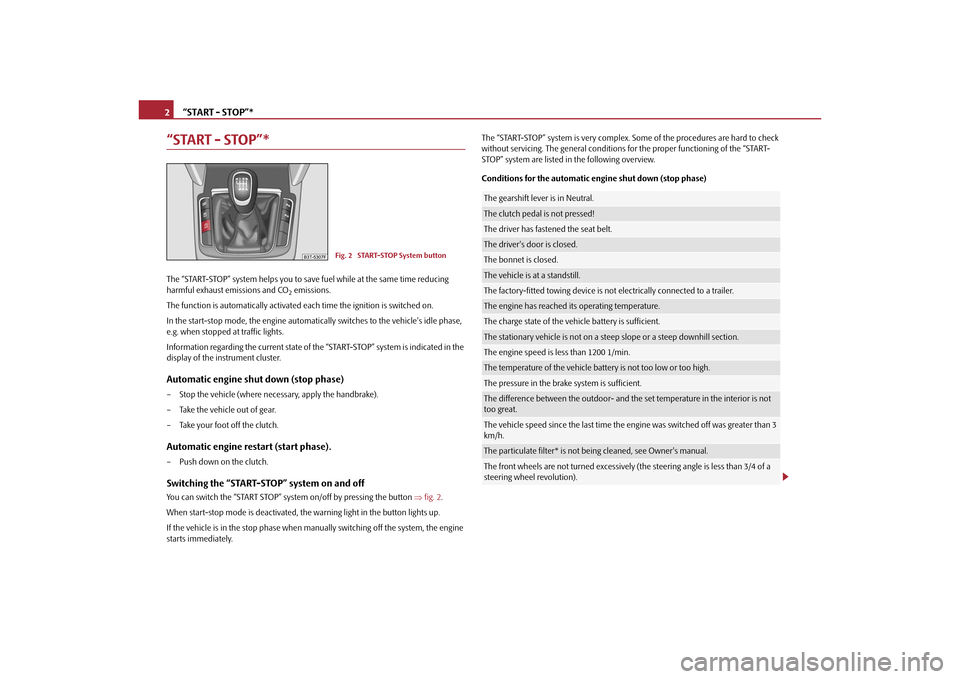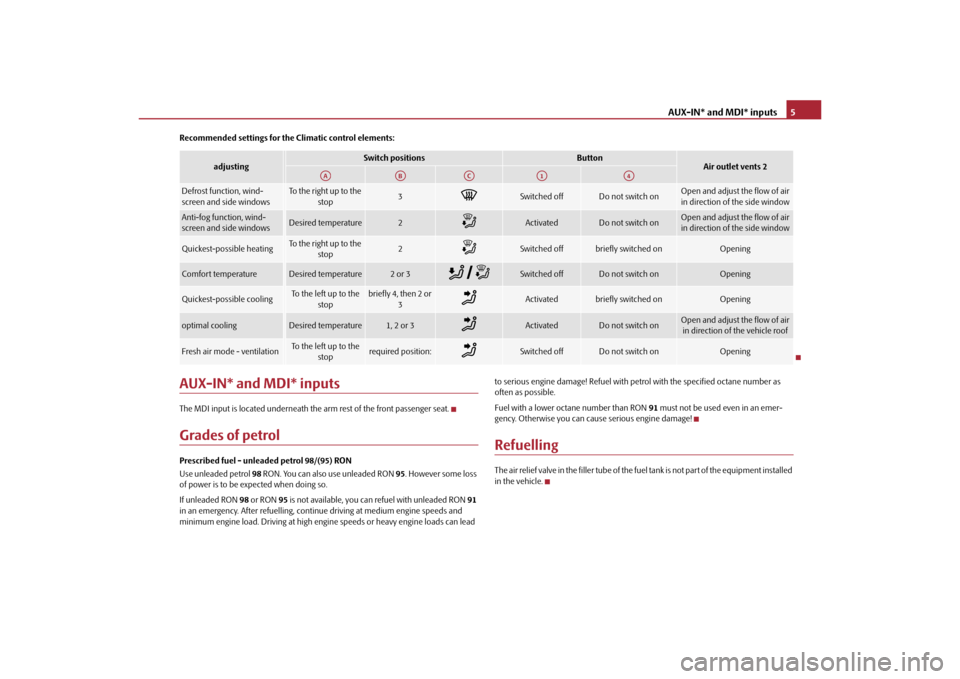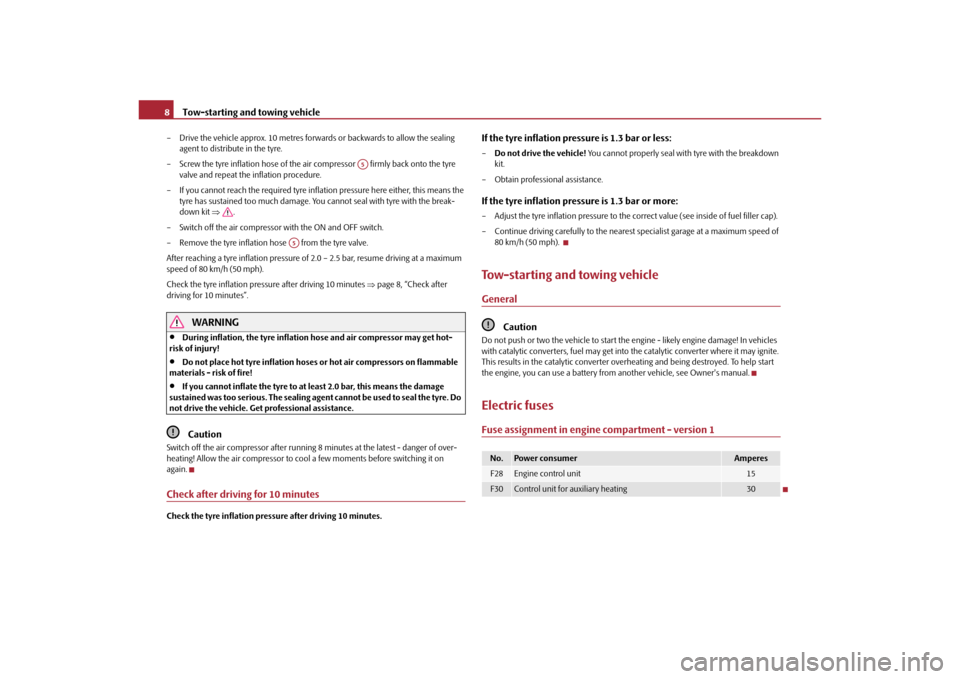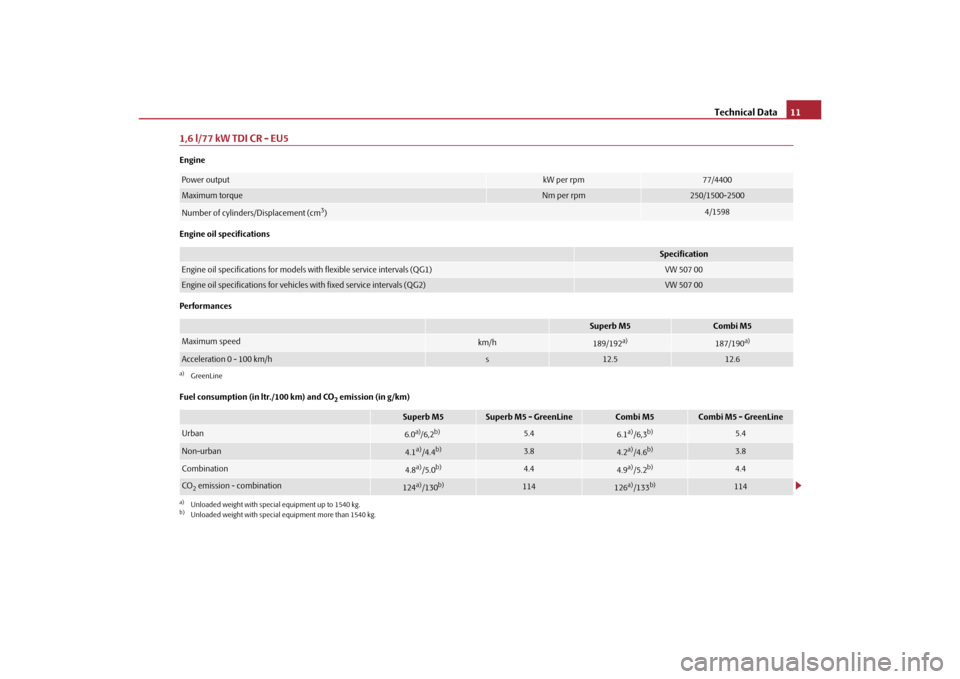fuel SKODA SUPERB 2010 2.G / (B6/3T) Technical Change
[x] Cancel search | Manufacturer: SKODA, Model Year: 2010, Model line: SUPERB, Model: SKODA SUPERB 2010 2.G / (B6/3T)Pages: 18, PDF Size: 0.76 MB
Page 3 of 18

“START - STOP”*
2
“START - STOP”*The “START-STOP” system helps you to save fuel while at the same time reducing
harmful exhaust emissions and CO
2 emissions.
The function is automatically activated ea ch time the ignition is switched on.
In the start-stop mode, the engine automatica lly switches to the vehicle's idle phase,
e.g. when stopped at traffic lights.
Information regarding the current state of th e “START-STOP” system is indicated in the
display of the instrument cluster.
Automatic engine shut down (stop phase)– Stop the vehicle (where nece ssary, apply the handbrake).
– Take the vehicle out of gear.
– Take your foot off the clutch.Automatic engine restart (start phase).– Push down on the clutch.Switching the “START-STOP” system on and offYou can switch the “START STOP” syst em on/off by pressing the button fig. 2 .
When start-stop mode is deactivated, the warning light in the button lights up.
If the vehicle is in the stop phase when ma nually switching off the system, the engine
starts immediately. The “START-STOP” system is very complex. Some of the procedures are hard to check
without servicing. The general conditions
for the proper functioning of the “START-
STOP” system are listed in the following overview.
Conditions for the automatic en gine shut down (stop phase)
Fig. 2 START-STOP System button
The gearshift lever is in Neutral.The clutch pedal is not pressed!The driver has fastened the seat belt.The driver's door is closed.The bonnet is closed.The vehicle is at a standstill.The factory-fitted towing device is not electrically connected to a trailer.The engine has reached its operating temperature.The charge state of the vehicle battery is sufficient.The stationary vehicle is not on a st eep slope or a steep downhill section.The engine speed is less than 1200 1/min.The temperature of the vehicle battery is not too low or too high.The pressure in the brake system is sufficient.The difference between the outdoor- and the set temperature in the interior is not
too great.The vehicle speed since the last time the engine was switched off was greater than 3
km/h.The particulate filter* is not being cleaned, see Owner's manual.The front wheels are not turned excessively (t he steering angle is less than 3/4 of a
steering wheel revolution).
s3lg.1.book Page 2 Monday, September 20, 2010 8:07 AM
Page 6 of 18

AUX-IN* and MDI* inputs5
Recommended settings for the Climatic control elements:AUX-IN* and MDI* inputsThe MDI input is located underneath the arm rest of the front passenger seat.Grades of petrolPrescribed fuel - unleaded petrol 98/(95) RON
Use unleaded petrol 98 RON. You can also use unleaded RON 95. However some loss
of power is to be expected when doing so.
If unleaded RON 98 or RON 95 is not available, you ca n refuel with unleaded RON 91
in an emergency. After refuelling, conti nue driving at medium engine speeds and
minimum engine load. Driving at high engine speeds or heavy engine loads can lead to serious engine damage! Refuel with pe
trol with the specified octane number as
often as possible.
Fuel with a lower octane number than RON 91 must not be used even in an emer-
gency. Otherwise you can ca use serious engine damage!
RefuellingThe air relief valve in the filler tube of the fuel tank is not part of the equipment installed
in the vehicle.
adjusting
Switch positions
Button
Air outlet vents 2
Defrost function, wind-
screen and side windows
To the right up to the
stop
3
Switched off
Do not switch on
Open and adjust the flow of air in direction of the side window
Anti-fog function, wind-
screen and side windows
Desired temperature
2
Activated
Do not switch on
Open and adjust the flow of air in direction of the side window
Quickest-possible heating
To the right up to the stop
2
Switched off
briefly switched on
Opening
Comfort temperature
Desired temperature
2 or 3
Switched off
Do not switch on
Opening
Quickest-possible cooling
To the left up to the
stop
briefly4, then 2or 3
Activated
briefly switched on
Opening
optimal cooling
Desired temperature
1, 2 or 3
Activated
Do not switch on
Open and adjust the flow of air in direction of the vehicle roof
Fresh air mode - ventilation
To the left up to the stop
required position:
Switched off
Do not switch on
Opening
AA
AB
AC
A1
A4
s3lg.1.book Page 5 Monday, September 20, 2010 8:07 AM
Page 9 of 18

Tow-starting and towing vehicle
8
– Drive the vehicle approx. 10 metres forw ards or backwards to allow the sealing
agent to distribute in the tyre.
– Screw the tyre inflation hose of the air compressor firmly back onto the tyre
valve and repeat the inflation procedure.
– If you cannot reach the required tyre inflation pressure here either, this means the tyre has sustained too much damage. You cannot seal with tyre with the break-
down kit .
– Switch off the air compressor with the ON and OFF switch.
– Remove the tyre inflation hose from the tyre valve.
After reaching a tyre inflation pressure of 2.0 – 2.5 bar, resume driving at a maximum
speed of 80 km/h (50 mph).
Check the tyre inflation pressure after driving 10 minutes page 8, “Check after
driving for 10 minutes”.
WARNING
•
During inflation, the tyre inflation hose and air compressor may get hot-
risk of injury!
•
Do not place hot tyre inflation hoses or hot air compressors on flammable
materials - risk of fire!
•
If you cannot inflate the tyre to at least 2.0 bar, this means the damage
sustained was too serious. The sealing agent cannot be used to seal the tyre. Do
not drive the vehicle. Get professional assistance.Caution
Switch off the air compressor after running 8 minutes at the latest - danger of over-
heating! Allow the air compressor to cool a few moments before switching it on
again.Check after driving for 10 minutesCheck the tyre inflation pressu re after driving 10 minutes.
If the tyre inflation pressure is 1.3 bar or less:–Do not drive the vehicle! You cannot properly seal with tyre with the breakdown
kit.
– Obtain professional assistance.If the tyre inflation pressure is 1.3 bar or more:– Adjust the tyre inflation pressure to the correct value (see inside of fuel filler cap).
– Continue driving carefully to the nearest specialist garage at a maximum speed of 80 km/h (50 mph). Tow-starting and towing vehicleGeneral
Caution
Do not push or two the vehicle to start the engine - likely engine damage! In vehicles
with catalytic converters, fuel may get into the catalytic converter where it may ignite.
This results in the catalytic converter overheating and being destroyed. To help start
the engine, you can use a battery from another vehicle, see Owner's manual.Electric fusesFuse assignment in engine compartment - version 1
A5
A5
No.
Power consumer
Amperes
F28
Engine control unit
15
F30
Control unit for auxiliary heating
30
s3lg.1.book Page 8 Monday, September 20, 2010 8:07 AM
Page 12 of 18

Technical Data11
1,6 l/77 kW TDI CR - EU5Engine
Engine oil specifications
Performances
Fuel consumption (in ltr./100 km) and CO
2 emission (in g/km)
Power output
kW per rpm
77/4400
Maximum torque
Nm per rpm
250/1500-2500
Number of cylinders/Displacement (cm
3)
4/1598
Specification
Engine oil specifications for models with flexible service intervals (QG1)
VW 507 00
Engine oil specifications for vehicles with fixed service intervals (QG2)
VW 507 00
Superb M5
Combi M5
Maximum speed
km/h
189/192
a)
a)GreenLine
187/190
a)
Acceleration 0 - 100 km/h
s
12.5
12.6
Superb M5
Superb M5 - GreenLine
Combi M5
Combi M5 - GreenLine
Urban
6.0a)/6,2
b)
a)Unloaded weight with specia l equipment up to 1540 kg.b)Unloaded weight with special equipment more than 1540 kg.
5.4
6.1a)/6,3
b)
5.4
Non-urban
4.1a)/4.4
b)
3.8
4.2a)/4.6
b)
3.8
Combination
4.8a)/5.0
b)
4.4
4.9a)/5.2
b)
4.4
CO2 emission - combination
124
a)/130
b)
114
126
a)/133
b)
114
s3lg.1.book Page 11 Monday, September 20, 2010 8:07 AM
Page 14 of 18

Technical Data13
2.0 ltr./103 kW TDI CR DPF - EU5Performances
Fuel consumption (in ltr./100 km) and CO
2 emission (in g/km)
Superb DQ6 4x4
Combi DQ6 4x4
Maximum speed
km/h
204
201
Acceleration 0 - 100 km/h
s
10.7
10.8
Superb DQ6 4x4
Combi DQ6 4x4
Urban
7.8
7.8
Non-urban
5.2
5.5
Combination
6.2
6.3
CO2 emission - combination
162
166
s3lg.1.book Page 13 Monday, September 20, 2010 8:07 AM
Page 17 of 18

Škoda Auto pursues a policy of constant product and model development. We trust
that you will understand that changes to models in terms of shape, equipment and
engineering, may be introduced at any time . The information about scope of delivery,
appearance, performances, di mensions, weight, fuel consumption, standards and
functions of the vehicle is only correct at the time of publication. Certain items of
equipment might only be installed later on (information given by the local authorised
Škoda Service Partner) and only envisaged fo r particular markets. It is therefore not
possible for legal claims to be made based on the data, illustrations and descriptions
contained in this Owner's Manual. Reprinting, reproduction or translation, eith
er in whole or in part, is not permitted
without the written consent of Škoda Auto.
Škoda Auto expressly reserves all rights relating to copyright laws.
We reserve the right to make changes to this document.
Issued by: ŠKODA AUTO a.s.
© ŠKODA AUTO a.s. 2010s3lg.1.book Page 16 Monday, September 20, 2010 8:07 AM